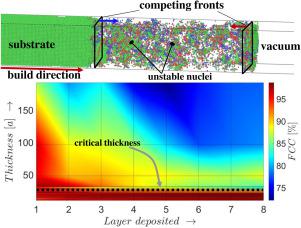Computational Materials Science ( IF 3.1 ) Pub Date : 2021-09-02 , DOI: 10.1016/j.commatsci.2021.110807 Gurmeet Singh 1 , Anthony M. Waas 1 , Veera Sundararaghavan 1

|
Additive manufacturing of a single crystalline metallic column at nanoscale is studied using molecular dynamics simulations. In the model, a melt pool is incrementally added and cooled to a target temperature under isobaric conditions to build a metallic column from the bottom up. The polyhedral template matching (PTM) is used to observe the evolution of atomic-scale defects during this process. The solidification is seen to proceed in two directions for an added molten layer. The molten layer in contact with the cooler lattice has a fast solidification front that competes with the slower solidification front that starts from the top of the melt layer. The defect structure formed strongly depends on the speed of the two competing solidification fronts. Up to a critical layer thickness, the defect-free single crystals are obtained as the faster solidification front reaches the top of the melt pool before the initiation of the slower front from the top. A slower cooling rate leads to a reduction in defects, however, the benefits diminish below a critical rate. The defect content can be significantly reduced by raising the temperature of the powder bed to a critical temperature. This temperature is governed by two competing mechanisms: the slower cooling rates at higher temperatures and the increase in amorphousness as one gets closer to the melting point of the metal. Finally, the effect of an added soft inclusion (SiS) and a hard inclusion (SiC) on the defect structures is explored. The hard inclusion leads to a retained defect structure while soft inclusions reduce defective content compared to the pure metal.
中文翻译:

通过分子动力学了解纳米级金属增材制造中的缺陷结构
使用分子动力学模拟研究了纳米级单晶金属柱的增材制造。在模型中,在等压条件下逐步添加熔池并冷却到目标温度,以自下而上地构建金属柱。多面体模板匹配 (PTM) 用于观察此过程中原子级缺陷的演变。对于添加的熔融层,可以看到凝固在两个方向上进行。与较冷晶格接触的熔融层具有快速凝固前沿,与从熔融层顶部开始的较慢凝固前沿竞争。形成的缺陷结构在很大程度上取决于两个相互竞争的凝固前沿的速度。达到临界层厚度,在较慢的凝固前沿从顶部开始之前,较快的凝固前沿到达熔池顶部,从而获得无缺陷的单晶。较慢的冷却速度会导致缺陷减少,但是,在临界速度以下,好处会减少。通过将粉末床的温度升高到临界温度可以显着降低缺陷含量。该温度由两种相互竞争的机制控制:较高温度下较慢的冷却速度和随着接近金属熔点而增加的非晶性。最后,添加软夹杂物 (SiS 通过将粉末床的温度升高到临界温度可以显着降低缺陷含量。该温度由两种相互竞争的机制控制:较高温度下较慢的冷却速度和随着接近金属熔点而增加的非晶性。最后,添加软夹杂物 (SiS 通过将粉末床的温度升高到临界温度可以显着降低缺陷含量。该温度由两种相互竞争的机制控制:较高温度下较慢的冷却速度和随着接近金属熔点而增加的非晶性。最后,添加软夹杂物 (SiS) 和缺陷结构上的硬质夹杂物 (SiC)。与纯金属相比,硬夹杂物导致保留的缺陷结构,而软夹杂物减少了缺陷含量。











































 京公网安备 11010802027423号
京公网安备 11010802027423号